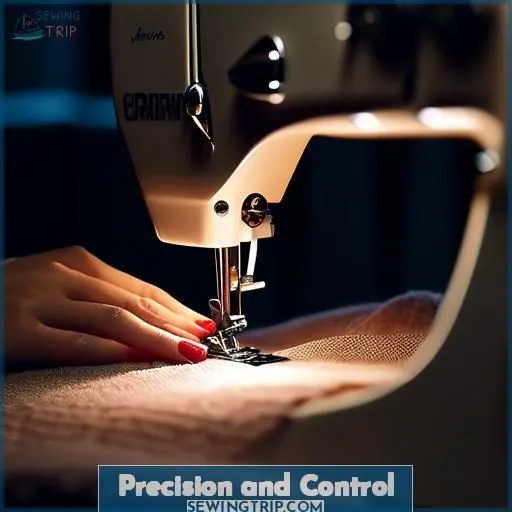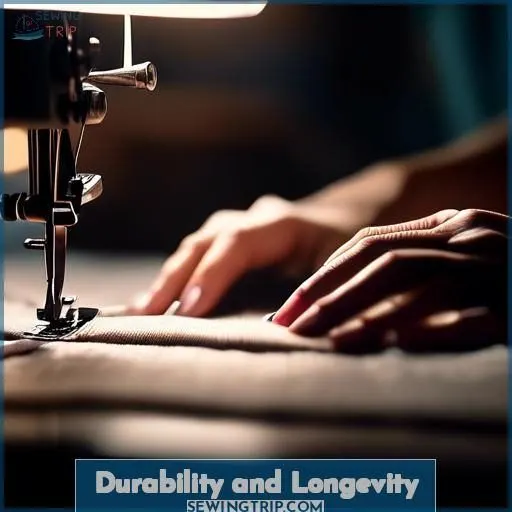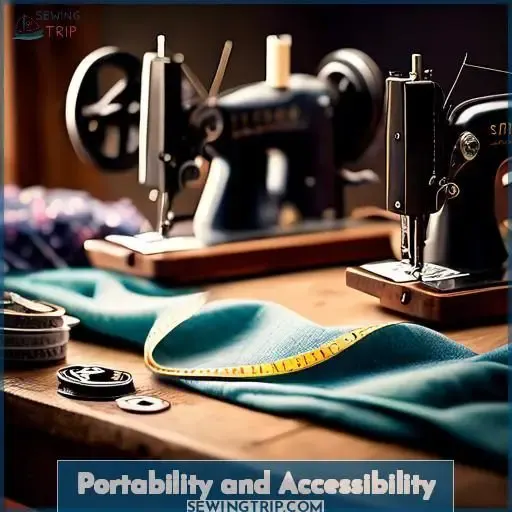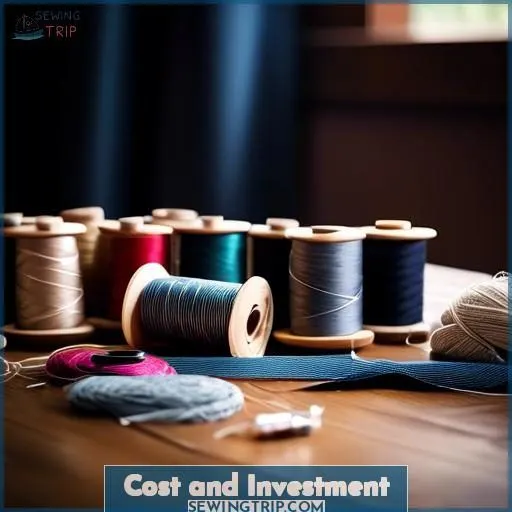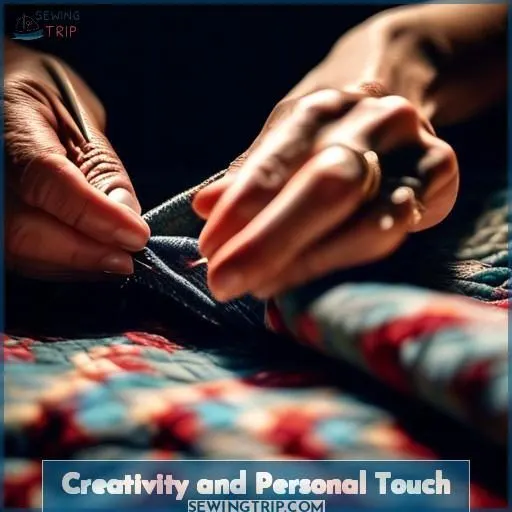This site is supported by our readers. We may earn a commission, at no cost to you, if you purchase through links.
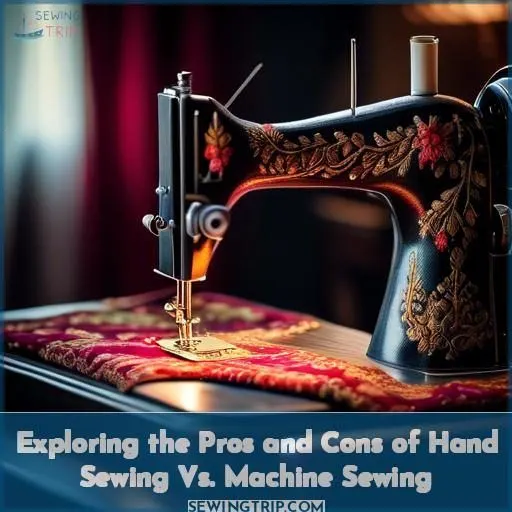
When deciding between hand sewing and machine sewing, the better choice depends on your specific needs. Hand sewing offers superior precision and control, making it ideal for intricate work and delicate fabrics. It also tends to be more durable and easier to repair.
Machine sewing is generally faster and more consistent, with the potential for long-term cost savings. However, the decision comes down to factors like the project, your skill level, and personal preferences.
If you’d like to explore the pros and cons of hand sewing vs. machine sewing in more depth, the key considerations are the project requirements, your skill level, and personal preferences.
Table Of Contents
Key Takeaways
- Hand sewing offers superior precision and control, making it ideal for intricate work and delicate fabrics, and tends to be more durable and easier to repair.
- Machine sewing is generally faster and more consistent, suitable for larger projects and working with thicker fabrics, and can potentially offer long-term cost savings.
- The choice between hand sewing and machine sewing depends on the project requirements, the individual’s skill level, and personal preferences, with each method having its unique advantages.
- Hand sewing allows for a more personal touch and customization in projects, while machine sewing provides a more professional look and is efficient for large-scale production.
Is Hand Sewing Better Than Machine?
Is hand sewing better than machine sewing? The answer depends on your project and personal preference. Hand sewing is often preferred for delicate fabrics, intricate designs, and repairs, as it offers a higher level of precision. Machine sewing, on the other hand, is faster and more efficient for larger projects.
Many sewists find value in both techniques, depending on their project needs. Factors to consider when choosing between hand and machine sewing include your skill level, budget, and satisfaction factor. While machine sewing may be more convenient, hand sewing can provide a more personalized and satisfying experience.
Ultimately, the choice between hand and machine sewing comes down to the specific requirements of your project and your personal preferences as a sewist.
Precision and Control
In the realm of precision and control, hand sewing provides a degree of customization that machine sewing can’t rival. With hand sewing, you possess the ability to modify your stitches’ length or orientation instantaneously, making it optimal for intricate work or challenging fabrics. This level of control is paramount when working with delicate fabrics, where a machine may compromise the material or produce uneven stitches.
Furthermore, hand sewing imparts a more personal touch, as each stitch is crafted by hand, bestowing upon your project a distinctive character that machine-sewn items can’t emulate.
Durability and Longevity
In terms of durability and longevity, hand stitching and machine stitching have their own unique strengths and weaknesses.
- Repair Techniques: Hand stitching is often more resilient due to the precision and control it provides. It’s also easier to restore when necessary, as the stitches are visible and accessible.
- Thread Longevity: Machine stitching can deliver more uniform results, but the thread may not last as long due to the increased speed and pressure.
- Material Compatibility: Hand stitching can be employed for a broader spectrum of materials, including delicate fabrics and embroidery. Machine stitching, on the other hand, is better suited for heavier fabrics and garment sewing.
- Environmental Impact and Maintenance: The environmental impact and maintenance demands of each method also contribute to their longevity. For example, hand stitching may necessitate more care and attention to preserve its strength over time.
Portability and Accessibility
Hand sewing is a traditional technique that has been around for centuries. It’s often considered more personal and allows for greater control over the stitching process. Hand sewing is particularly useful for smaller projects, such as repairs, embroidery, and cross-stitch. It’s also ideal for working with delicate fabrics that may not hold up well under the pressure of a sewing machine.
Machine sewing, on the other hand, is a more modern technique that has become increasingly popular due to its speed and convenience. Machine sewing is ideal for larger projects, such as garment sewing and quilting. It’s also more suitable for working with thicker fabrics that can be challenging to sew by hand.
When it comes to portability and accessibility, hand sewing has a clear advantage. Hand sewing tools, such as needles, thread, and scissors, are small and easy to carry. This makes hand sewing a great option for travel or for those who want to sew on the go. In contrast, machine sewing requires a sewing machine, which can be bulky and difficult to transport.
In terms of accessibility, hand sewing is also more versatile. Hand sewing can be done anywhere, as long as you have a quiet space to work. This makes it a great option for those who want to sew in different locations or who don’t have access to a sewing machine. Machine sewing, on the other hand, requires a dedicated space and a power source.
Hand sewing also offers more control over the stitching process. Hand stitches can be made as small or as large as desired, and the stitch length can be adjusted to suit the fabric being used. This level of control isn’t possible with machine sewing, which relies on pre-set stitch lengths and widths.
Cost and Investment
Shifting gears from portability to the nitty-gritty of cost and investment, let’s delve into the financial aspects of sewing. The initial investment in machine sewing might make your wallet squirm, but ponder the long-term savings. With machine sewing, you’re anticipating faster production and potentially reduced maintenance expenses over time.
Conversely, hand sewing’s budget concerns are modest initially, but it demands a time commitment. Weighing the cost-to-benefit equation between hand and machine sewing can be like balancing a needle on a thread—challenging, but imperative for your sewing adventure.
Creativity and Personal Touch
Hand sewing offers a unique and personal touch to your projects, allowing you to express your creativity through intricate embellishments and decorative details. The ability to use a wider range of materials and create unique designs adds to the charm of hand-stitched items. Hand sewing is also ideal for repairs, embroidery, and cross-stitch, as well as for attaching patches or appliqués. The precision and control you have over each stitch make it perfect for invisible stitching, such as hems or linings. However, hand sewing can be time-consuming and may not be as consistent as machine sewing.
On the other hand, machine sewing provides a more professional look and can handle thicker materials, making it suitable for large-scale production. It’s faster and more efficient, allowing you to produce consistent results. Machine sewing is ideal for garment sewing, quilting, and buttonholes. However, it may not offer the same level of control over stitch length and direction as hand sewing, and it can be more expensive due to the initial cost of the machine and ongoing maintenance fees.
Frequently Asked Questions (FAQs)
Can hand sewing be used for large-scale projects?
Hand sewing can be used for large-scale projects, but it may require more time and patience compared to machine sewing. Some large-scale hand sewing projects include crazy quilting, embroidery, and even sewing clothing items like shirts or dresses. However, hand sewing may be more suitable for smaller, more intricate projects or for adding decorative elements to larger projects.
How does hand stitching compare to machine stitching in terms of cost?
In the dance of dollars, hand stitching often takes the lead in the cost waltz, demanding more for its time and personal touch, while machine stitching pirouettes with efficiency, trimming the budget’s waistline.
Is hand stitching suitable for heavy fabrics?
Hand sewing can be suitable for heavy fabrics, but it requires the use of appropriate needles and thread, as well as a slow and steady pace to produce a precise stitch. The right type of needle for heavy fabrics is a leather needle, and a strong, waxed thread is ideal for hand stitching. Additionally, a slow and steady pace is essential to prevent hand fatigue and produce a more precise stitch.
Hand stitching can create durable and long-lasting seams, but it’s more time-consuming and may not be as efficient as machine stitching for large-scale production or heavy fabrics.
Can machine stitching produce unique designs?
You might think hand stitching’s got the monopoly on uniqueness, but machine stitching can churn out intricate, original designs too, especially with today’s digital embroidery machines.
Is hand stitching more cost-effective in the long run?
Hand sewing can be more cost-effective in the long run, especially for small projects or repairs, as it can last longer and be more durable than machine-sewn items. Additionally, hand sewing can be more personal and allow for unique designs that may not be possible with machine sewing.
However, the cost-effectiveness of hand sewing depends on factors such as the type of material used, the quality of stitching, and the frequency of use. Machine sewing can be more cost-effective for larger projects or for mass production, as it’s faster and more efficient.
Conclusion
Weaving the fabric of your project, you’ll find that whether hand sewing is better than machine sewing hinges on your unique tapestry of needs. Precision, durability, and a personal touch favor the needle in your hand, while speed and consistency highlight the machine’s allure.
Your choice should stitch together the project’s demands, your expertise, and your preferences, ensuring the final seam aligns perfectly with your vision.
Choose the method that best suits the pattern of your sewing journey.

